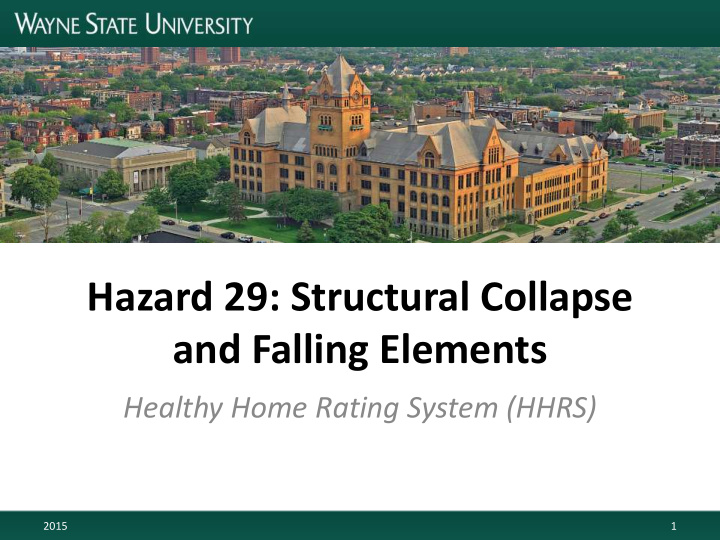



Hazard 29: Structural Collapse and Falling Elements Healthy Home Rating System (HHRS) 2015 1
Description of the Hazard • The structural collapse category covers the threat of whole dwelling collapse, or a part of the dwelling being displacing or falling because of inadequate fixing, disrepair, or as a result of adverse weather conditions. • Structural failure may occur internally or externally, threatening the occupants or members of the public. 2015 2
Potential for Harm • There is no particular age group more vulnerable than others. 2015 3
Health Effects and Causes • Objects falling from the fabric of a building and as a result causing injury are extremely rare. Potential injuries range from minor bruising to death. • External hazards include falling slates, eaves gutters, bricks, windows, and the collapse of walls. • Internal hazards include floor, ceiling, and staircase collapse. • The most common incident is for a fixture, such as a light fitting or kitchen cabinet, to fall from the ceiling or wall because of a combination of poor fixings and vibration. • The most common part of the fabric of buildings to fall and injure someone is ceiling plaster. 2015 4
Relevant Matters Affecting Likelihood 1. Structural movement – evidence of continuing movement 2. Structural cracks, etc. – cracks and/or bulges to external walls 3. Open joints – to brick, stone or block work to external walls or chimney stacks 4. Cladding defects – loose render or other insecure external finish to external walls 5. Loose coping(s) – to parapet or balcony walls or to chimney stacks 6. Loose guarding – to balconies, roof terraces, etc. 7. Structural damage – to balconies, etc. 8. Disrepair to lintels/sills – cracks or other disrepair around openings to external and internal walls 9. Insecure frames or hinges – to either windows or doors 10. Roof movement – sagging, distorted or spreading to the roof structure 11. Loose roof covering – loose or slipped roof slates, tiles etc. 12. Loose pots – to chimney stacks 13. Insecure rainwater goods – including eaves gutters and/or external pipework 14. Staircase failure – springy, distorted or other indications of failure of staircase structure 15. Insecure guarding – to staircases and/or landings 16. Defective ceilings – cracked, damp and/or bulging ceilings 17. Defective internal walls – cracked and/or bulging internal walls 18. Insecure internal frames – loose door frames or hinges 19. Loose fittings or fixtures – loose cupboards, shelves or handrails 2015 5
Relevant Matters Affecting Severity of Outcomes 1. Height above ground – The height of the building or of the element above the ground or floor 2. Size/weight of element – The size, weight and nature of the object or element likely to fall 2015 6
Hazard Prevalence: National • In a national sample of 130,112 housing units from the 2009 American Housing Survey: – 2,765 (2.13%) had a sagging roof – 5,805 (4.46%) had missing roof material – 2,020 (1.55%) had a hole in the roof – 3,175 (2.44%) had missing bricks, siding, or outside wall material – 1,687 (1.30%) had sloping outside walls – 2,822 (2.17%) had foundation crumbling or an open crack or hole 2015 7
Hazard Prevalence: Metro Detroit (MI) • In metro Detroit (1,900,600 housing units in Wayne, Macomb, Oakland, Monroe, Livingston, St. Clair, & Lapeer counties): – 54,500 (2.87%) had a sagging roof – 73,500 (3.87%) had missing roof material – 40,000 (2.10%) had a hole in roof – 72,300 (3.80%) had missing bricks, siding, or other outside wall material – 31,800 (1.67%) had sloping outside walls – 52,000 (2.74%) had foundation crumbling or an open crack or hole 2015 8
Hazard Prevalence: Oakland (CA) • In the Oakland metropolitan area (895,000 housing units in Alameda & Contra Costa counties): – 35,000 (3.91%) had a sagging roof – 51,400 (5.74%) had missing roof material – 35,500 (3.97%) had a hole in roof – 35,700 (3.99%) had missing bricks, siding, or other outside wall material – 27,500 (3.07%) had sloping outside walls – 33,100 (3.70%) had foundation crumbling or an open crack or hole 2012 9
Healthy Home Rating System Project Leadership Lyke Thompson Carrie Beth Lasley Angie Sarb David Ormandy Director Research Associate Research Assistant Professorial Fellow CUS/WSU CUS/WSU CUS/WSU University of Warwick (313) 577-5209 (313) 577-9280 (313) 577-8911 +44 (0) 76524 936 ad5122@wayne.edu cblasley@wayne.edu msorbo@med.wayne.edu david.ormandy@warwick.ac.uk 2015 10
Recommend
More recommend